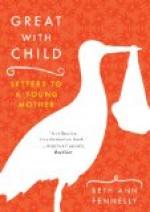SEC. 2. Form of the Dress.
On this subject a writer in the London Literary Gazette of some eight or ten years ago, lays down the following general directions, to which, in cold weather, there can be but one possible objection, which is, they are not alamode, and are not, therefore, likely to be followed.
“All that a child requires, so far as regards clothing, in the first month of its existence, is a simple covering for the trunk and extremities of the body, made of a material soft and agreeable to the skin, and which can retain, in an equable degree, the animal temperature. These qualities are to be found in perfection in fine flannel; and I recommend that the only clothing, for the first month or six weeks, be a square piece of flannel, large enough to involve fully and overlap the whole of the babe, with the exception of the head, which should be left totally uncovered. This wrapper should be fixed by a button near the breast, and left so loose as to permit the arms and legs to be freely stretched, and moved in every direction. It should be succeeded by a loose flannel gown with sleeves, which should be worn till the end of the second month; after which it may be changed to the common clothing used by children of this age.”
The advantages of such a dress are, that the movements of the infant will be, as we have already seen, free and unrestrained, and we shall escape the misery of hearing the screams which now so frequently accompany the dressing and undressing of almost every child. No chafings from friction, moreover, can occur; and as the insensible perspiration is in this way promoted over the whole surface of the body, the sympathy between the stomach and skin is happily maintained. A healthy sympathy of this kind, duly kept up, does much towards preserving the stomach in a good state, and the skin from eruptions and sores.
But as I apprehend that christianity is not yet very deeply rooted in the minds and hearts of parents, I have already expressed my doubts whether they are prepared to receive and profit by advice at once rational and physiological. Still I cannot help hoping that I shall succeed in persuading mothers to have every part of a child’s dress perfectly loose, except the band already referred to; and that should be but moderately tight.
Common humanity ought to teach us better than to put the body of a helpless infant into a vise, and press it to death, as the first mark of our attention. Who has not been struck with a strange inconsistency in the conduct of mothers and nurses, who, while they are so exceedingly tender towards the infant in some points as to injure it by their kindness, are yet almost insensible to its cries of distress while dressing it? So far, indeed, are they from feeling emotions of pity, that they often make light of its cries, regarding them as signs of health and vigor.
There can be no doubt, I confess, that the first cries of an infant, if strong, both indicate and promote a healthy state of the lungs, to a certain extent; but there will always be unavoidable occasions enough for crying to promote health, even after we have done all we can in the way of avoiding pain. They who only draw the child’s dress the tighter, the more it cries, are guilty of a crime of little less enormity than murder.




